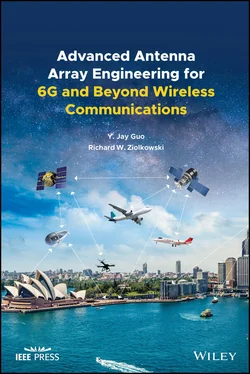Consequently, there have been very real and intense industry pushes and market pulls for various modern antenna systems to empower current fifth‐generation (5G) and future sixth‐generation (6G), and beyond wireless devices, applications, and their associated ecosystems. Scientific and engineering progress in array technologies has particularly benefited from user and stakeholder cravings for higher data rates and lower latencies. Antenna arrays will continue to play a major role in all future wireless generations. Pioneering wireless array research typically stresses advanced features such as steerable beams, multi‐beams, multiband antenna coexistence, antenna reconfiguration, low‐cost feed networks, and conformity to platforms. The various conundrums associated with the evolving land, air, and space networks associated with them will challenge all of us to develop fundamental and applied electromagnetics breakthroughs to solve them.
Under this backdrop, we have had the great privilege of working with a number of very talented PhD students, postdoctoral fellows, visiting scholars, and international collaborators. Our mutual interest and joint research efforts in antennas and antenna arrays for current 5G (fifth‐generation) and future 6G, and beyond wireless ecosystems have deepened our understanding of their fundamentals, as well as their practical considerations necessary to successfully deliver useful systems for commercial applications that actually satisfy most of their generally overambitious, initial performance goals.
Our presentation of antenna and antenna arrays for current 5G and evolving 6G, and beyond systems in this book is organized into eight logical chapters that reflect our thoughts and the findings generated in those endeavors. Consequently, we are deeply indebted to our colleagues for their dedication and great contributions to the state of the art which are highlighted in these chapters. In particular, we would like to acknowledge specific inputs to them as follows:
Chapter 2: Ji‐Wei Lian, Visiting Student, University of Technology Sydney (UTS), Australia
Chapter 3: Prof. Ming‐Chun Tang, Chongqing University, China
Chapter 4: Dr. Can Ding, Lecturer, UTS, Australia and Dr. Hai‐Han Sun, postdoctoral researcher, Nanyang Technology University (NTU), Singapore
Chapter 5: Dr. He Zhu, postdoctoral researcher, UTS, Australia
Chapter 6: Dr. Pei‐Yuan Qin, Senior Lecturer, and Ph.D student Li‐Zhao Song, UTS, Australia
Chapter 7: Dr. Stanley (Shulin) Chen, postdoctoral researcher, UTS, Australia; Dr. Debabrata K. Karmokar, Lecturer, University of South Australia, Australia; Prof. José Luis Gómez Tornero, Technical University of Cartagena, Spain; and Ji‐Wei Lian, visiting student at UTS, Australia; Prof. Zheng Li, Beijing Jiaotong University, China.
Chapter 8: Prof. Yanhui Liu, Research Principal, UTS, Australia, and Ming Li, PhD student, UTS, Australia.
We thank them all for their invaluable time and efforts and wish them even greater successes in their future endeavors and careers.
We would also like to express our gratitude to University of Technology Sydney (UTS) for their whole‐hearted support to our antennas research team.
Finally, we happily acknowledge our wives, Clare Guo and Lea Ziolkowski, and thank our lucky stars for their endless understanding, support and patience, particularly when we disappear for uncountable hours on cosmic efforts such as this :-)
1 A Perspective of Antennas for 5G and 6G
The roll‐out of the fifth generation (5G) of wireless and mobile communications systems has commenced, and the technology race on the sixth‐generation (6G) mobile and wireless communications systems has started in earnest [1, 2]. 5G promises significantly increased capacity, massive connections, low latency, and compelling new applications. For example, device‐to‐device (D2D) and vehicle‐to‐vehicle (V2V) communication systems will help facilitate the realization of autonomous transport. The rapid access to and exchange of “Big Data” will increasingly impact real‐time economic and political decisions. Similarly, highly integrated, accessible “infotainment” systems will continue to alter our social relationships and communities. Wireless power transfer will replace cumbersome, weighty, short‐life batteries enabling widespread health, agriculture, and building monitoring sensor networks with much less waste impact on the environment. 6G networks aim to achieve a number of new features such as full global coverage, much greater data rates and mobility, and higher energy and cost efficiency. These will usher in new services based on virtual reality/augmented reality and artificial intelligence [3].
At the core of wireless devices, systems, networks, and ecosystems are their antennas and antenna arrays. Antennas enable the transmission and reception of electromagnetic energy. Antenna arrays enhance our abilities to direct and localize the desired energy and information transfer. To achieve the many stunning and amazing 5G and 6G promises, significant advances in antenna and antenna array technologies must be accomplished.
1.1 5G Requirements of Antenna Arrays
One of the most important features of 5G is the employment of massive antenna arrays, with the size of the array currently varying from 64 to 128 and 256 elements. Such a large number of antenna elements in an array provide an unprecedented variety of possibilities. These include a means to increase the network capacity; the distance and data rates of individual links between the base station and mobile users; and the reduction of interference between different users and cells.
1.1.1 Array Characteristics
Generally speaking, there are three ways to exploit the benefits of antenna arrays in 5G wireless communication systems [4, 5], namely diversity, spatial multiplexing, and beamforming. These concepts are explained as follows.
a) Diversity and Diversity Combining
It is a fact that mobile wireless communication channels typically suffer from both temporal fading and frequency fading. As a consequence, the quality of the channel varies with time and across different frequencies. Thus, the specific characteristics of the two propagation channels observed between any two pairs of transmitting and receiving antennas are usually different due to the variation in the scattering along the corresponding propagation paths. The peaks and troughs of the strength of the received signal at one antenna would be different from those at another antenna in a rich scattering environment. If the correlation between those two signals is low, one can combine them through so‐called diversity combining to obtain a greater signal‐to‐interference‐and‐noise ratio (SINR). The latter is also known as diversity gain. A simple viewpoint is that diversity combining techniques aim to improve the quality of the individual links between the base stations and the user terminals by increasing the SINR.
From an antenna point of view, diversity can be obtained by exploiting either the distance between adjacent antennas, i.e., their positions, or different polarizations at the receiver and the transmitter. However, a fundamental requirement is that the mutual coupling between these diversity antennas must be low. Most modern base station antennas employ polarization diversity, i.e., each antenna element is dual‐polarized typically with two pairs of slanted dipole “arms” in the ±45° directions. In 5G millimeter‐wave (mm‐wave) systems, for example, a popular antenna configuration is to have beamforming antenna arrays with ±45° polarizations, respectively.
b) Spatial Multiplexing
Multiplexing is the process of combining multiple digital or analog signals into a data stream for their transmission over a common medium, thus sharing a scarce resource. Spatial multiplexing aims to establish separate data streams in parallel using the same time/frequency resources. Thus, the space dimension is reused, i.e., multiplexed.
Читать дальше












